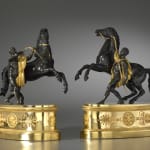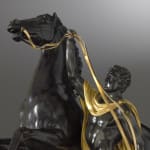Guillaume I Coustou
Provenance
From an important private German collection.
A fine pair of Empire gilt and patinated bronze statuettes based on models of the Marly Horses by Guillaume I Coustou, each with a patinated bronze athletic male groom wearing only a loosely draped gilt cloak standing beside a rearing patinated bronze horse with flowing tail and mane, each horse and tamer in contraposto pose standing on a gilt bronze oval base mounted on the sides with star motifs and anthemion
Paris, date circa 1810-20
Height 44.5 cm, width 37 cm. each.
These imposing bronzes are based on the great marble statues portraying horses restrained by grooms, known as the Marly Horses by Guillaume I Coustou (1677-1746), which were commissioned in 1739 by Louis XV for the horse pond in the gardens at the Château de Marly and were installed in 1745. Coustou's statues, carved from single blocks of Carrara marble were executed 1743-45 to replace the gap left when the equestrian statues of Fame and Mercury, commissioned by Louis XIV from Coustou's uncle Antoine Coysevox (1640-1720), were removed to the Tuileries.
From the mid eighteenth century small bronze replicas of Coustou's originals were produced in Paris, of which there is a pair of such examples dating from circa 1750-85 in the Hermitage Museum, Saint Petersburg. The present bronzes are not however direct reduced replicas of Coustou's creations but follow their basic design, which as here showed two rearing horses in contraposto pose being attended by their fearless grooms. The inspiration for Coustou's work was probably derived from the antique statues the Dioscuri, each with rearing horses and attendant tamers standing close by, which still stand in front of the Palazzo del Quiranale in Rome. He may also have been inspired by other works such as The Horses of Apollo Groomed by Tritons or The Horses of the Sun executed by the brothers Gaspard and Balthazar Marsy installed in the Parc de Versailles 1672 (a model of which is now in the Louvre). But above all Coustou drew inspiration from nature itself, by studying the movements of men and horses from live models. In 1697 Coustou won the Grand Prix de Sculture and was duly sent to Rome. On his return, he set up an atelier in Paris and was subsequently engaged with his brother Nicolas and his uncle Coysevox at the Château de Marly under the direction of Jules Hardouin-Mansart, premier architect des Batîtments to Louis XV.
Though the Château de Marly was destroyed during the Revolution, thankfully Coustou's Marly Horses were spared. On the initiative of the painter Jacques-Louis David, in 1794/5 the marbles were moved to Paris where they were placed on high pedestals in the Place de la Révolution (now the Place de la Concorde) at the bottom of the Champs-Elysées but more recently in 1984 were removed to the Musée du Louvre.
From the outset The Marly Horses were heralded among the greatest masterpieces of the 'new age' of French sculpture, a view that continued throughout the nineteenth century when they were admired by the author Victor Hugo who referred to them as "those neighing marbles.....prancing in a cloud of gold". Because Coustou's grooms were intended to represent American Indian slaves his works pre-empted Rousseau's ideal of 'the noble savage', which in itself was a notion that inspired many Directoire and Empire artists. Moreover the Marly Horses, with their emphasis on the struggle between wild steeds and muscular naked men was a heroic subject and again was one that appealed to Empire sensitivity.



